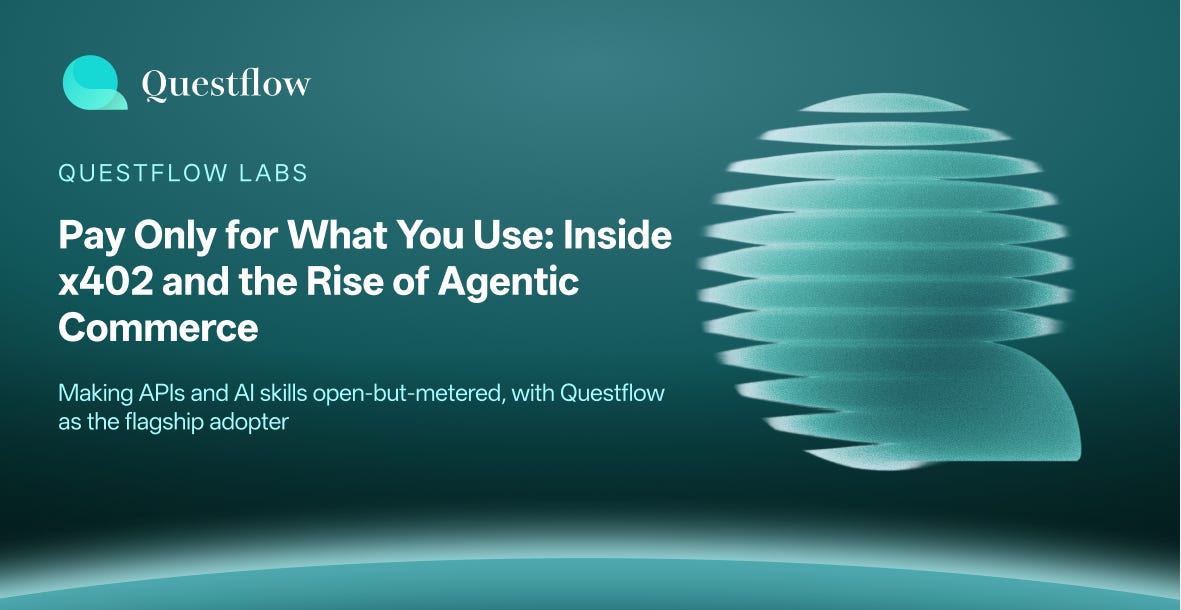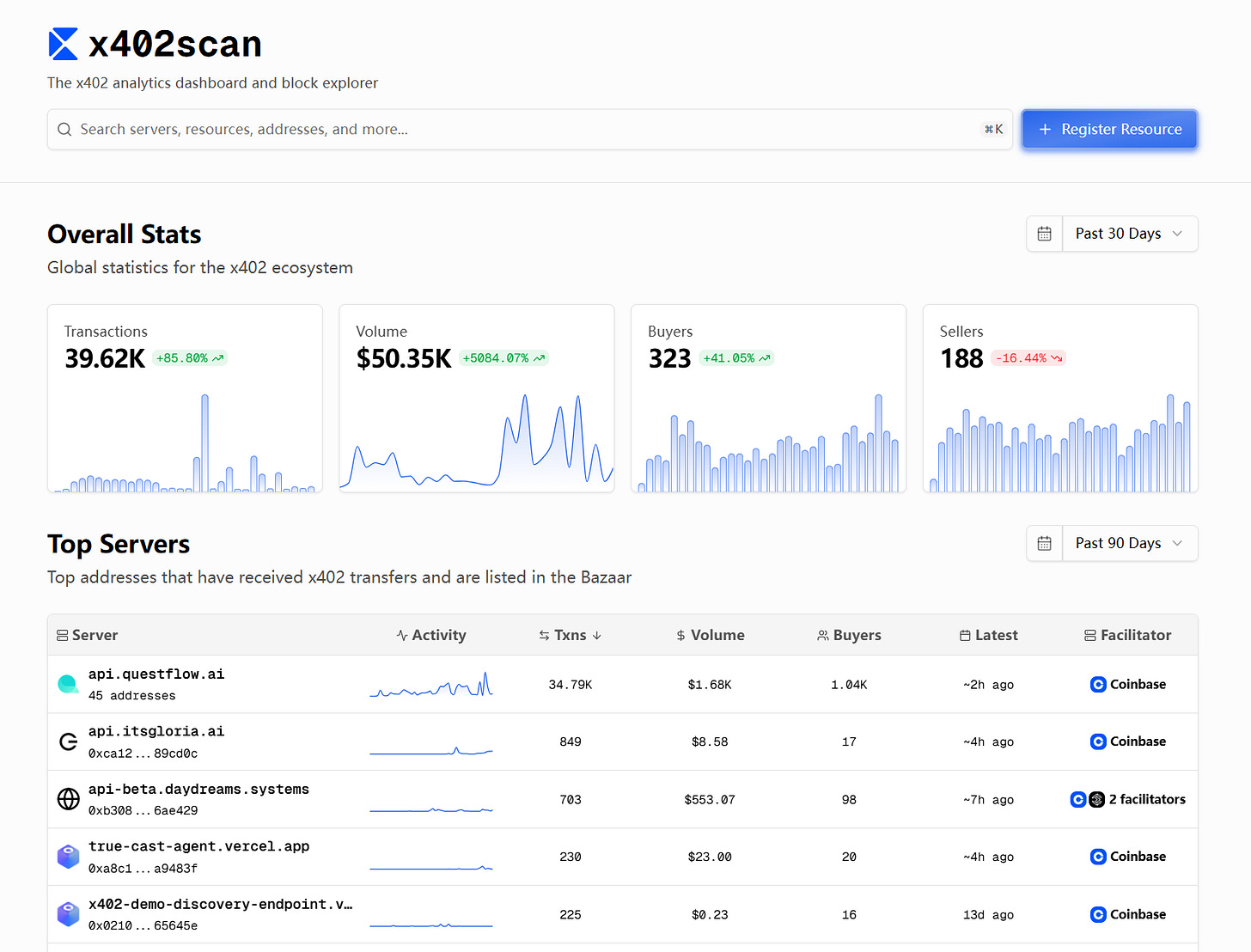Pay Only for What You Use: Inside x402 and the Rise of Agentic Commerce
Making APIs and AI skills open-but-metered, with Questflow as the flagship adopter
Why a Payment Layer for the Web, Now?
For 30 years, the web ran on a simple recipe: links for discovery, HTTP for delivery, and ads or subscriptions to pay the bills. That model breaks down in a world where:
AI agents call thousands of APIs autonomously.
Microtasks (a translation, a vector look-up, a one-off inference) should cost fractions of a cent.
Developers want to expose useful endpoints without forcing sign-ups, OAuth, or monthly plans.
Enter x402—a protocol that turns the long-dormant HTTP 402 Payment Required into a live, internet-native checkout for per-request payments. It’s simple: a server can reply “402” to say “this resource costs X,” the client (human or agent) attaches a tiny, verifiable payment, and the server returns the goods. No accounts, no cards, no platform lock-in.
This post is a deep, vendor-neutral tour of what x402 is, why it’s timely, how it works, and where the ecosystem is heading—with a special spotlight on Questflow, a leading adopter whose agent swarms already drive the lion’s share of x402 payments.
What x402 Is—in One Breath
x402 is an open, HTTP-native protocol for pay-per-use access to web resources (APIs, files, services). It revives HTTP 402 as a first-class “paywall with instructions”: the server specifies the required payment; the client resubmits the request with a cryptographically verifiable payment payload; the server verifies/settles it (often via a facilitator service), then responds normally (200 OK + content).
Key ideas:
Open & chain-agnostic: Designed to work across blockchains/tokens (stablecoins are the pragmatic default).
Web-first UX: Pure HTTP status codes and headers; drop-in server middleware and lightweight client SDKs.
Tiny, instant payments: Built for micropayments and agent-to-agent (A2A) commerce.
No account creation: Public endpoints become “open but metered”—anyone (or any agent) can pay and use.
The Why: A Missing Primitive for AI + Web3
AI made this inevitable
Agents are already planning trips, summarizing docs, parsing receipts, calling retrieval endpoints, and coordinating with other agents. Their native language is APIs, not card forms. Charging per API call is economically natural; subscription walls aren’t.
Stablecoins made this feasible
For years, “micropayments on the web” failed because card rails and on-chain gas were too slow/expensive. Modern L2s + stablecoins flip that math: penny-level transfers clear in seconds with negligible fees.
HTTP 402 made this ergonomic
We don’t need a new messaging bus. HTTP already tells clients what to do next. Turning “402” from a dead letter into a price-tag and set of payment instructions is the ergonomic unlock for developers.
How x402 Works (Without the Jargon)
Client requests
/expensive-endpoint.Server replies 402 with a JSON “Payment Required” body: price, token(s), network(s), recipient, and any constraints.
Client pays (or prepares a signed voucher) and retries the same request with an
X-Paymentheader carrying the payment payload.Server verifies & settles, typically by calling a facilitator (an API that checks the payment and, if valid, pushes settlement on-chain).
Server returns 200 OK with the actual content plus an optional
X-Payment-Responseconfirming the settlement details.
That’s it. No cookie walls. No secrets in query strings. Just stateless HTTP with a one-shot payment proof attached.
Design choices that matter
Facilitators, not custodians. A facilitator only validates and settles what the client signed for. It can’t repurpose funds.
Plurality by default. Multiple facilitators, tokens, and chains can co-exist; the server lists acceptable options; the client picks.
Extensible schemes. Beyond “pay-now,” the spec is evolving to include deferred/aggregated payments (useful for crawling, batched jobs, or end-of-day settlement).
What You Can Build (Immediately)
Metered APIs: Price per request, per token, per MB, per second of inference—without onboarding users.
Paid content / data: Micro-paywalled PDFs, datasets, dashboards; no adtech, no cookie fatigue.
Agent marketplaces: Skills, tools, and data sources priced at cents; agents pay agents as workflows compose.
Usage-priced infra: Pay-as-you-go storage, pinning, scraping, PDF-to-text, or OCR—exposed safely to the open web.
One-off actions: “Tip the author $0.50,” “run this one-shot model,” “fetch this paywalled page now.”
The common thread: no signup. The price is the permission.
The Ecosystem (What’s Real Today)
Even without blasting numbers, the shape of the x402 landscape is clear:
Facilitators: Coinbase’s hosted facilitator jump-started the first wave. Community and platform facilitators (self-hosted Rust/Node, multi-chain vendors, cloud/CDN integrations) broaden choice and reduce concentration risk.
Developer tooling: Server middleware for common frameworks (Express, Fastify, etc.), client SDKs for browsers/agents, and observability for payment headers/receipts.
Discovery & “Bazaar”: Indexes where agents can find x402-enabled endpoints (prices, tokens, capabilities), then pay-and-use instantly.
Vertical pilots: Pinning providers (pay-per-pin), scraping/readability services (pay-per-page), content/LLM plugins (pay-per-call), and “tip” APIs for social/content.
Momentum now flows from A2A patterns: once agents can both buy and sell services with cents-level settlement, a long tail of useful micro-APIs suddenly makes business sense.
Case Study: Questflow as a Flagship A2A Adopter
Disclosure: This is an independent, third-party perspective; we highlight Questflow because its agents demonstrably account for a dominant share of current x402 activity.
What Questflow is. A multi-agent orchestration engine where agent swarms coordinate across web2/web3 services. Users design outcomes; agents perform tasks; payments flow between them per action.
Why x402 fits. Questflow’s core loop is modular: each sub-task (fetch data, transcode a file, classify text, trigger a trade, post an update) is a billable unit. With x402:
Agents expose skills at a posted price (often fractions of a cent).
Other agents pay on call; no whitelisting or manual keys.
The user pays only for what they used, not a blunt subscription.
Settlement is immediate and on-chain, so the swarm can trust itself.
What this unlocks. In practice you see many tiny transfers per workflow—exactly the pattern legacy rails couldn’t support at scale. The effect is twofold:
Composability beats bundling. One “big” SaaS becomes ten specialized agents tied by x402.
Monetization meets merit. If your agent is genuinely useful, it earns—instantly, transparently—without BD deals, gated APIs, or billing ops.
As an ecosystem signal, Questflow shows how x402 turns an architectural ideal (A2A commerce) into a working market. It’s the difference between a slide and a ledger.
Governance & Standardization: Keeping It Open
Protocols win when they’re neutral, boring, and everywhere. The x402 path to that outcome looks like:
Open spec & reference impls. Multiple languages, self-hostable facilitators, and conformance tests.
Foundation stewardship. A neutral home to evolve schemes (e.g., deferred payments, subscriptions, discounts), certify compatible facilitators, and prevent vendor capture.
Web infra allies. CDN/platform support (e.g., “pay-per-crawl” or “pay-per-edge-function”) bakes x402 into the fabric of the web.
Wallet UX. Browser/agent wallets that understand 402, show the price, apply limits (“≤$0.25/day on scraping”), and sign in one tap.
This is the “HTTPS moment”: once a few big infra pieces default to “402 means ‘here’s how to pay’”, the path of least resistance for builders is to support it.
Crypto, Cards, and Pragmatism
x402 is crypto-forward but not crypto-fundamentalist:
Stablecoins are pragmatic: global, programmable, low-fee, and instant—perfect for cents-level pay-per-use.
Multiple settlement options are on the table: present-day flows favor stables on L2s; future flows can include deferred invoices, RTP, or even card-backed abstractions if someone wraps them into a verifiable
X-Paymentscheme.UX can abstract custody. Users can top up with fiat; agents spend stables via per-site limits; all they see is “this costs $0.03—allow?” The chain can remain an implementation detail.
The point isn’t “on-chain maximalism”; it’s programmable, verifiable, low-latency settlement. Right now, stablecoins do that best.
What Changes When 402 Is Alive
APIs become storefronts. A doc page with a cURL example + price is all you need.
Agent SEO is real. If agents are buyers, your capability graph + price is your listing.
The long tail wakes up. Niche skills/data that never penciled out under subscriptions become viable at $0.002/call.
Post-purchase shifts left. Refunds, retries, and SLAs become programmatic: the same header that paid can carry credits, dispute proofs, or validator attestations.
Trust becomes composable. Pair x402 with an agent identity/reputation layer (e.g., ERC-8004-style registries for identity/validation feedback) and agents can safely select each other across org boundaries.
Build Tracks (Actionable for the Next 90 Days)
For API/product teams
Add a 402 middleware to 1–2 endpoints; publish a clear price; watch usage you never got under OAuth.
Instrument cost-per-result and tune: many teams discover they were under- or over-pricing once frictions vanish.
Offer both free tier (limited) and 402 tier (uncapped, metered). Let users graduate organically.
For agent builders
Treat payments as a tool call. If an endpoint returns 402, your agent should: parse → compare options → pay within policy caps → continue.
Implement allowances (per domain/day/category). Log every spend; surface receipts to users.
Sell a skill in the Bazaar. Even a tiny, polished capability can earn daily if priced right.
For infra & wallets
Ship an X-Payment-aware wallet UX: “allow up to $N/day on *.example.com.”
Offer facilitator APIs with guardrails (KYT hooks, spend policies, org controls).
Add deferred schemes for crawlers/batch jobs; settle per hour/day with verifiable receipts.
For research & trust layers
Prototype validation frameworks: k-of-n re-execution for high-stakes tasks; attach attestations to payment receipts.
Publish reputation signals (delivery success, refund rates, validator outcomes) in agent cards.
Why Questflow Matters to the Protocol’s Story
A protocol is only as convincing as its most demanding user. Questflow’s swarms are that stress test:
They multiply calls (fan-out orchestration), so performance and latency matter.
They price diversity (from sub-pennies to dollars), so schemes must be flexible.
They prove A2A at meaningful scale, demonstrating that autonomous value exchange isn’t just academic.
Today, Questflow represents a disproportionate share of x402 payment flow—not as a single point of failure, but as proof of product-market fit for agentic micropayments. As more agent platforms adopt the same primitives, we expect the distribution to even out—but the pattern will stay: lots of tiny, meaningful payments, continuously.
The Web Learns to Transact
The web gave us universal reach for information. x402 adds a universal, low-friction way to move value alongside it—precisely sized to the resource consumed, precisely when it’s needed, and understandable to both browsers and bots.
For AI, it’s how agents become economic participants, not just API tourists.
For Web3, it’s a practical rails story: stablecoins doing what they do best, invisibly.
For builders, it’s a way to open the doors wider—no signup, just price—and let usage, not funnels, decide who you reach.
We’ve been waiting three decades for 402 to mean something. Now it does.



